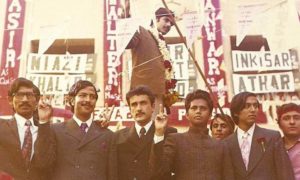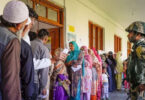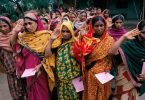By Awais Qarni/Umar Shahid
Youth is the barometer of society’s conditions. A large number of conscious youngsters consist of students, whose social status analysis can assess the levels of mass psychology at that particular moment in time. Youth and students have played a vital role in the history of Pakistan. From campus politics to rebellion against dictators, students effectively played their revolutionary role. Where students have turned the tide of history – various political and religious parties have used them for their political interests and power. The incidents of Qaid e Azam University Islamabad, Punjab University Lahore, Gomal University D. I. Khan, Mardan University and the University of Peshawar are pointing out the decline of student politics. In the past, fee increases and other students welfare-related issues were the main foundations of students politics whereas now students organizations are limited to fight over petty issues and ethnic prejudices. They have often indulged into bullying for extortion and become tools for interests of sections of the ruling classes. The birth of reactionary organizations like Jamiat, APMSO, and others is based on obscurantism and chauvinism. If there is any wrongdoing on the student, then there is a combination of Jamiat or similar outlets.
The history of student politics in Pakistan has been contrary to the current situation, so it is hard to understand today’s situation without understanding its past. There is a marvellous history of student politics that traces its foundation in the pre-partition subcontinent when students offered their lives in the fight for their rights. From bloody partition of India to the dark period of Pakistan under Zia, various left-leaning students’ organizations have frolicked their role in changing history. During the Zia period in 1984, all student unions were banned and left-wing organization suffered under this bigoted rule. Before this there was a regular practice of holding elections in colleges and universities; in these elections, various student organization participated on youth’s political, educational, cultural and socioeconomic issues. The first government of Benazir Bhutto (1988-1990) tired to softened union’s ban but his successor Nawaz Sharif’s government took anti-students’ rights position and again banned students unions. Zia Ul Haq’s reactionary ban, eliminated basic nurseries, which gave ideological basis to the politics and a process of depoliticizing society was started. Later, its disastrous ramifications were expressed in the general political situation of the country.
In 1947, there was only one student organization, Muslim Students Federation (MSF), that was working as the Muslim League’s student wing. The result of the breakdown of the MSF was an inevitable process of party breakdown. In its aftermath progressive factions, along with left-wing students formed the Democratic Students Federation (DSF). The leftwing leadership of DSF launched various movements for student’s rights and fought bravely against the Pakistani State. Similarly, it opposed the US and western Imperialism and held solidarity protests with the global anti-imperialists movement. Significant amongst these was the solidarity marches for the defense of the nationalization of Suez Canal by Jamal Abdul Nasir. Due to its revolutionary role and courage, DSF became popular in the country’s educational institutions and achieved successes in all major educational institutions in the 1951 students’ union elections. DSF had criticized the Pakistani government on its pro-American policies. To eliminate the left’s growing influence in society, the Communist Party of Pakistan was banned after the so-called Rawalpindi conspiracy case. When the state failed to unify the ruling elites scattered MSF it resorted to banning the DSF. In response to State repression on DSF, the left wing student activists started organizing “All Pakistan Students Organization” (APSO). APSO appeared as a major pressure group of left students. But at this juncture, this platform was also banned after the clashes with Police and violence in Karachi.
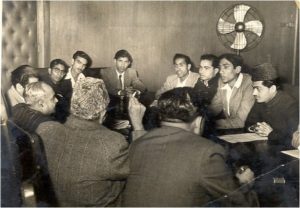
DSF members meet government officials in 1953 and demand the construction of a new university in Karachi. The government agreed, but soon banned DSF.
Meanwhile, the National Students Federation (NSF) that built its wide-ranging foundations that effectively filled the political vacuum left by DSF. DSF’s revolutionary comrades also joined NSF. NSF became the focal point of youth expectations in most major educational institutions and the country’s largest progressive students’ organization in the early 1960s. Soon NSF left ideas radicalized more and gained influence in educational institutions, before ruling class started to attack the NSF. In 1958 Field Marshal Ayub had imposed a military dictatorship. The results of the 1950s-60s students union elections clearly manifested the reality that youth of this region had no support for the fundamentalist organizations.
According to an estimate, in these elections, DSF won 50%, NSF by 35%, MSF 10%, and Islamic Jamiat students was able to get only 5% votes. On US imperialist dictations Ayub dictatorship continued the ban on the Communist party but the political consciousness of students and resentment in society can be thoroughly assessed by these results. During this time, Jamaat-e-Islami’s student wing, the Islami Jamiat-e-Talaba, had a derisory presence in various educational institutions but their sole purpose was to violently counter progressive organizations.
However serious differences surfaced between the NSF and DSF in this period mainly due to ‘Sino-Soviet’ split between Moscow and Beijing bureaucracies. Although these were progressive organizations and had a strong basis in educational institutions but sharp contradictions also emerged in their supporters inside the institutions. The Communist party and DSF were banned while the NSF kept working. The DSF that was following the Soviet Union and Moscow and NSF supported Beijing but the ideological foundations of these two organizations were the same, ‘the two-stage theory’. The Communist Party lagged far behind conscious of society during the 1968-69 revolution and that led to the disintegration of the DSF. After the 1965 war, the populist socialist rhetoric of Zulfiqar Ali Bhutto attracted a large layer of youth. Many of left activists, NSF members, and other progressive layers joined Pakistan People’s Party (PPP) and promoted socialist ideology in the PPP. Some of them also became ministers in Bhutto’s first cabinet. But the process of breakdown within the NSF also continued and organization splintered into different groups. A group continued to work with PPP with its anti-Mujib and Pakistani nationalist agenda. While the other group that had split away on a liberal and secular agenda later emerged as the Sindh National Students Federation (SNSF). Although all the factions of the NSF were popular due to their splits, opportunities for the rightwing student organizations flourished in the mid seventies. Since the Pakistan People’s Party was not a Marxist-Leninist party, instead of adopting the path of revolutionary socialism the leadership chose the parliamentary path and took power to carry out reforms. After gaining the power, Bhutto carried out the 1972 killings of workers in Karachi. NSF sharply criticized Bhutto’s the reconciliatory right policies. As a result, the PPP launched its own students’ front People’s Students Federation (PSF) and even it was built by some of the NSF students who were close to Bhutto. At that point of time, PSF’s main objective was to fight against NSF. But at the same time, Jamiat was getting stronger in the University of Karachi and gained a large share of votes in 1970’s university elections. However, in the 1972 elections, the NSF in the form of Alliance with other progressive student groups (BSO, Pukhtoon SF, DSF and other factions) won all major Karachi educational institutions. The Dow Medical College continued to sustain a popular base of the PSF and it also started taking steps in mainstream politics in the same year. In order to stop the progressive students activities during 1972, Jamiat extremists launched “Thunder Squad” campaign, which was the same as Yogi Adityanaath’s Romeo Squad in today’s India. Due to the pressure exerted on Bhutto, from the left wing within the ranks of PPP, a purge of the left started from 1973 onwards. This led to expelling of the PPPs Marxist founders such as J. A Rahim and Mairaj Muhammad Khan.
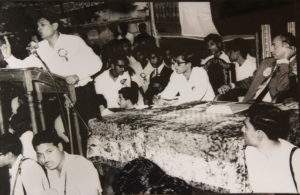
The NSF president Mairaj Muhammad Khan addressing the reception of the NSF held in 1966-early 1967. Zulfikar Ali Bhutto was the chief guest, The federation’s presidency handed over to Rasheed Hassan (sitting next to Bhutto) in this event.
Pakistan State’s military intervention in Balochistan of 1974 turned many students of Baloch Students Organizations (BSO) into anti PPP government camps. In this period, the Party took a sharp right turn when feudal lords were being promoted and the government declared Friday as a state holiday, Qadianies as non Muslim minority, ban on alcohol consumption and so on. Owning to these policies, where a majority of left-wing students were disappointed with the PPP while the right-wing reactionary forces gained momentum. Despite of all this, PSF as a progressive student organization had a vast basis in the whole country. This was especially true in Central and South Punjab, and also in Peshawar University. In name of rigging in 1976 elections; Jamaat-e-Islami with other right-wing parties formed Pakistan National Alliance (PNA) movement for the imposition of Nizam-e-Mustafa (System of the Prophet). In this movement Jamaat e Islami has organised a large number of demonstrations. There were clashes in most areas of Punjab and Sindh. The CIA was behind the PNA’s movement and this unrest created a situation where the brutal General Zia overthrew the Bhutto government and imposed another martial law in the night of 4-5 July 1977. After which the worst attacks were carried out on the activists and sympathisers of the progressive student organizations.
From then on, left wing students’ organizations bravely fought against the military tyranny that sponsored the growth of religious fundamentalist students organisations. The left won many seats in students’ union elections by formulating Alliances with left parties in Karachi, Northern Punjab, Islamabad, Lahore, and Peshawar. But with the backing of the vicious state, the Islamic reactionaries took union elections in major institutions such as Karachi and Punjab Universities. The most severe crackdown on progressive organizations was launched when Zulfiqar Ali Bhutto was hanged in April1979, the only prayer funeral in absentia throughout Pakistan was organised by the Multan’s left and progressive students in Nishtar Medical College. The students’ leadership in its vengeance was flogged, tortured, and incarcerated by the military regime. In the same year, despite the clashes and conflicts, the left wing organisations participated in union elections where ever these were held. An alliance of left and progressive organizations secured tremendous victory in Karachi but the Jamiat won one important seat. He was Hussain Haqqani who at present is dissident of state and an imperialist stooge based in the US. The Islamic Jamiat-e-Islami resorted to heavy weapons to crush and victimize its left opponents. To crush the Afghan Saur revolution, on edicts of US Imperialism, arms were introduced throughout the country in the name of the ‘Dollar Jihad’. After which armed conflicts and clashes in educational institutions became a routine. Since then, this shipment of weapons could not be eliminated from educational institutions by any regime till today.
Fearing the students’ struggles turning into a mass movement against him, Zia ul Haq imposed a ban on student unions after his fake referendum. Progressive organizations, which became part of the Restoration Democracy movement (MRD) or any other anti-government movement, were prosecuted. Most students went underground or escaped into exile. The religious and ethnic right-wing student’s organizations became agents of the repressive state. All Pakistan-Mohajir Students Organization (APSMO) was one that later morphed into MQM to atomize the working classes and control situation of Karachi by inciting religious, ethnic and communal hatreds. The new versions of Muslim Leagues were created in order to give a democratic facade to the brutal dictatorship. Students who raised their voice for political and economic rights were imprisoned and labeled as terrorists, agents of the Soviet Union or Murtaza Bhutto’s Al-Zulfiqar, an organisation based on armed resistance to the military rule. In reality, the state and the ruling classes were taking revenge from the students and laborers for their daring to rise up in the revolution of 1968-69. In 1988 Zia dictatorship reached its destruction by a military plane’s crash, in which Zia was accompanied by US imperialist. But the poison of religious and ethnic sectarianism that it had unleashed is still prevailing in society, educational institutions and amongst the backward layers of society. Conservatism perpetrated student politics and division of left also damaged it a lot. The ban on student union has never been lifted.
The 2008 Pakistan Peoples Party Government cosmetically declared in the Assembly to lift the ban from student unions but it never took the union-making process serious. With their struggle in the 1968-69 revolution, student organizations also achieved many concessions that included basic education, special discount in buses and trains’ rentals, sports in educational institutions and other non-circular activities, art related to human nature, rhyme and enlightenment of students in literacy, educational matters, curriculum setting, new college and universities, hostels and other facilities. Not only this, but student organizations have been present as an important element in the general politics and culture of the country. Male and female students combined educational circles were set up in institutions. Due to the ban on student unions, the students are also cut off from this so-called Bourgeois democracy, that’s why a large number of youth today have little or no interest in the politics, elections, its democracy, and parliament. Where it has a positive effect on their conscious in form of eliminating their beliefs on capitalism, there are negative effect of distancing from ideological politics.
In the past, student organizations had their stands on different ideologies, so that there was a debate in society, even students had a lots of discussions on hoe to fight against oppression. Although these days there is no overt repression of Zia Ul Haq’s level, but the menance of hooliganism, violence and lusts for glitter and money which had been instilled into student politics. Today’s students are in a constant state of alienation. Due to the privatisation of education, the students are being kept in terrible conditions and economic hardships. Where there are different international brand outlets in the plazas, small and suffocated rooms of these plazas are being named as University and College. The state is incompetent in providing free education. Large numbers of youth are deprived from education because of not being able to afford it. However, layers of the middle class minimize their daily expenses and manage some of the costly educational costs for future employment.
Due to such a large number of students, there are two to three shifts in almost every educational institution. In these non-productive and useless hours, these students are suffering severe problems in life. They suffer from sleep disorder on a vast scale in Pakistan and are increasingly having negative effects are on the abilities to learn and utilize their talent. Awkward times of sleeping and awakening of people have become a routine, facilities such as technology, internet and mobile cause an indefinite and irregular routine in backward and deprived communities hence there are more negative and minimal positive benefits of these gadgets. Its effects can be seen in society and it also limits the person’s degree of talent and development. Sports and other non-academic activities have almost vanished and there is growing drug addictions as a result of which its biggest market is the student areas.
Recently, bourgeois media revealed morphing drugs rackets in universities. Dawn News reported that there is an astonishing rise of female students in the use of drugs but due social sanctions and conservative ideas such women are unable to utilize their talent and suffer from aging at a younger age. The unbearable educational costs and psychology of competition to increase the quality of life artificially – there are organized gangs present in universities which engage these females into prostitution for short cuts to riches.
The real reason for the suffering of youth is the commercialization and commodification of education that has now become the most profitable business. The State has neither the infrastructure nor the finances to accommodate the huge number of students wanting the education. The purpose of the entry test and other types of examinations is to promote psychopathic competitions among youth and to limit the number of opportunities for them through these examinations.
Youth from the deprived classes who are not able to attain seats in educational institution abandon their education or commit suicide. On the other hand, whoever has the wealth can easily become a private engineer on his finance even from the foreign country. This is dual standard of class education and system. It is meant to safeguard the system of the privileged upper class. The elites are striving to eradicate and denigrate student’s politics. They are afraid of the revolt, unity, and strength of the students. Although in the minds of youth there is a vague idea of student politics but still the revolutionary role of students is a nightmare for ruling classes.
Those who fought bravely and were victorious against the Ayub & Zia dictatorships, those who laid the foundation of a traditional party of the working class have been betrayed even by their own party. Today, the PPP and every other elite political party is apologetic for capitalism in the name of democracy and in a race to serve the interests of the ruling class. The ban on student unions manifests the same fear. Opportunities for youth to sit together and spend time are being eradicated in campuses. Dhaba culture that emerged near the universities is being crushed. Zia’s terror is showing its ugly and bloodied tentacles today. It reactionary protégés are not only killing innocent people, but also the educational institutions that have been converted into virtual jails. The scene of entering your own institution is equivalent to crossing an international border. Every possible step is being taken to wither away conscious of youth’s revolutionary role. These dirty tactics of the ruling class can dominate in ordinary times, but in the revolutionary periods, all of these obstacles will be smashed by the rising tide.
After the ban on students union, the most controlled process started in the form of dividing students on different regional, religious, sectarian, ethnic and linguistic basis. In all the educational institutions, whose students organizations rose up against tyranny in the 60s, 70s, and 80s, the linguistic divisions emerged in the form of ‘councils’. However, at the time of this semi-stagnant period, the students hesitate to join any council, but if any council is formed then its role is limited to organizing annual cultural programs instead of highlighting the student issues. Activities of these councils are strictly limited and non political. The sufferings of the semester system have taken away all the moments of happiness and joy. If the leadership of a council wants to do something, then the semester ends and the leadership that usually consists of senior students often graduate and leave the institute. This vicious cycle keeps going on.
The main activity of these educational councils is to ensure admissions of students from their ethnicity. With the changing situation, these student’s councils may have to transform themselves on the class basis or they shall perish. The regional, national and cultural basis will have to be linked to that of students’ rights struggle and organization. A few elite educational institutes tried to conduct union elections and many ‘societies’ formed for such purpose. But to enter in these institutes are mere dreams for the majority of the working class youth. Even the middle class doesn’t have access to these institutions. The role of the student societies is not as that of the unions in the past. These are just elections of various societies, and not based on any ideology or student’s problems, because there is same dominant theory and class of both the voters and the recipients. In these institutions, the only purpose of unionization is to prepare the next generation of rulers. This is the case as a practice or drill for the off springs of the elite.
Whereas left and progressive politics has declined the ideological politics of the Islamicists and right-wingers is also in the midst of the crisis. Today there are no solid ideological foundations of any organization in any educational institute. Just as we have seen in the past events, when the students showed concern against the lynching of Mashal Khan in the spontaneous solidarity marches, they also raised up against Jamiat in response to violence against them or the oppression of Gender Studies students in Punjab University in 2014 and a later incident in Karachi University when students attacked the girls’ playing cricket, saw a serious rebuttal and strong response. In those incidents, when students fought at all levels exposed the hollow nature and false fear of religious organizations. In many places, students forced the administration to knee before their demands for example by the management of the Multan Education University. In the last days, if we have seen the student unrest in Lahore, Dera Ismail Khan, Islamabad, Hyderabad and Peshawar, one thing is clear that a serious alternative for students is needed. Where there is a need to introduce revolutionary ideologies to the existing councils, organizations, and societies, there is also a need to keep in mind that there is a huge number of students present outside of these cultural organizations. To reach these layers and introducing them to the politics of the unionisation and the glorious past of the students power and its crucial role in historical movements that transformed societies, is the primary task of revolutionaries. Due to the role of the sectarian and ethnic organizations the vacuum in students politics must be filled by building the foundation of a true revolutionary organization, which shall fight against chauvinistic, religious, sexual and sectarian prejudices.
Fighting students’ battles on class basis is the only real fight!

